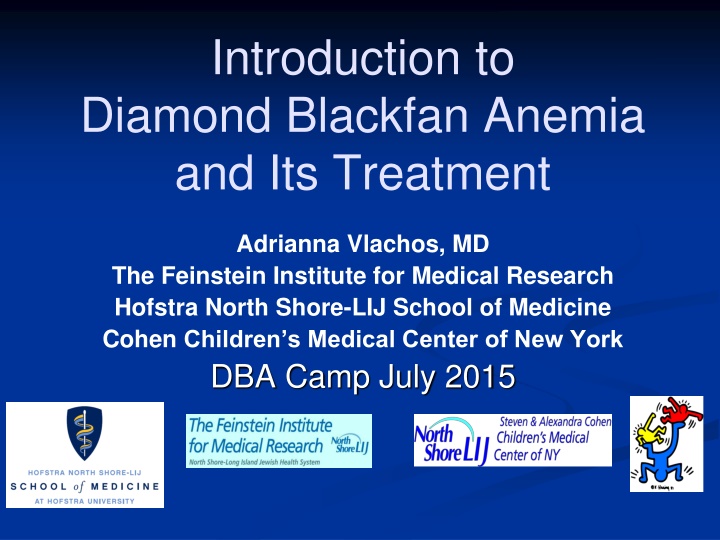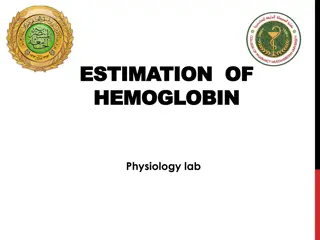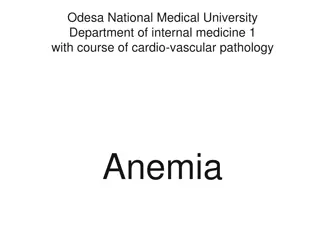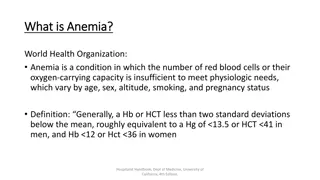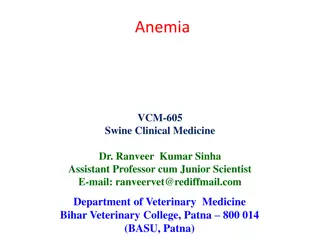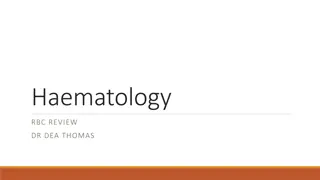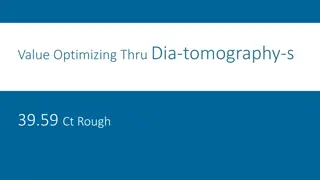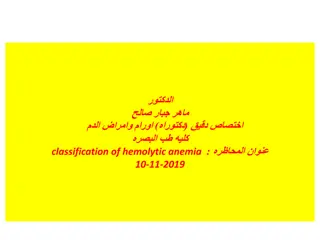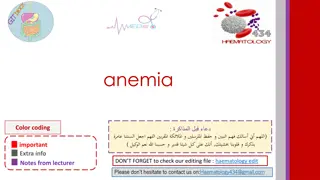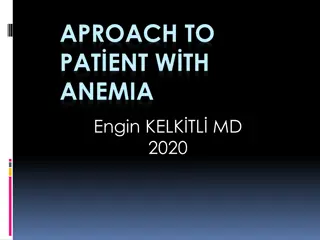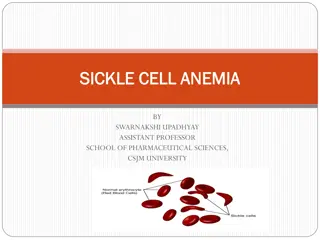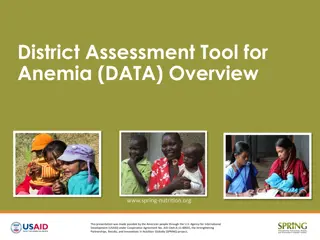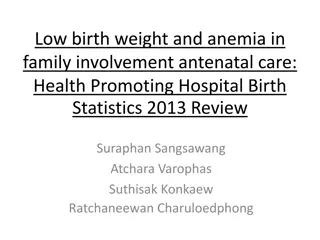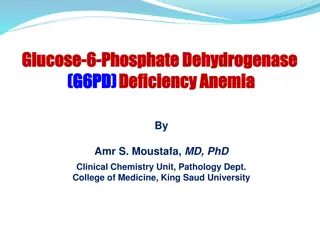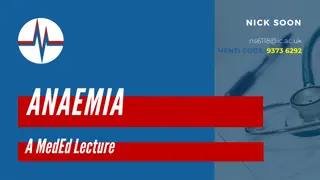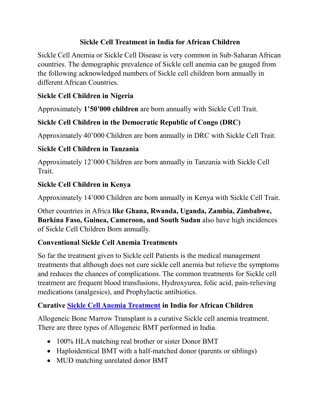Introduction to Diamond Blackfan Anemia and Its Treatment
This article provides an in-depth overview of Diamond Blackfan Anemia (DBA), including definitions, diagnosis, genetics, demographics, treatments like corticosteroids and transfusion therapy, and future directions. It also highlights the DBA Registry and the collaboration with various medical professionals and institutions. DBA is explained as an inherited bone marrow failure syndrome with shared characteristics with other IBMFS, such as clinical manifestations, congenital anomalies, and cancer predisposition. The content discusses the importance of the DBAR Team and the DBA Surveillance and Awareness Program in managing DBA cases.
Download Presentation

Please find below an Image/Link to download the presentation.
The content on the website is provided AS IS for your information and personal use only. It may not be sold, licensed, or shared on other websites without obtaining consent from the author.If you encounter any issues during the download, it is possible that the publisher has removed the file from their server.
You are allowed to download the files provided on this website for personal or commercial use, subject to the condition that they are used lawfully. All files are the property of their respective owners.
The content on the website is provided AS IS for your information and personal use only. It may not be sold, licensed, or shared on other websites without obtaining consent from the author.
E N D
Presentation Transcript
Introduction to Diamond Blackfan Anemia and Its Treatment Adrianna Vlachos, MD The Feinstein Institute for Medical Research Hofstra North Shore-LIJ School of Medicine Cohen Children s Medical Center of New York DBA Camp July 2015
Diamond Blackfan Anemia Definitions Diagnosis Genetics DBA Registry Demographics Congenital Anomalies Outcomes Remission Proven Treatments Corticosteroids Transfusion Therapy and Iron Chelation Stem Cell Transplantation Experimental Treatments Leucine Sotatercept Cancer Future Directions
DBAR Team Diamond Blackfan Anemia Registry Adrianna Vlachos, MD Jeffrey M. Lipton, MD, PhD Eva Atsidaftos, MA Jessica Kang, BS 1-888-884-DBAR
DBA SAP Team DBA Surveillance and Awareness Program Adrianna Vlachos, MD Jeffrey M. Lipton, MD, PhD Johnson Liu, MD - Medical Hematology Sandeep Jauhar, MD Cardiology Yael Toby Harris, MD Endocrinology Phyllis Speiser, MD Pediatric Endocrinology
Acknowledgements DBA patients, their families, and their physicians Diamond Blackfan Anemia Foundation Daniella Maria Arturi Foundation Pediatric Cancer Foundation NHLBI (R01 and Resequencing Project) CDC DOD Our numerous collaborators
Collaborators National Human Genome Research Institute/NIH David Bodine, PhD Kelly O Brien University of Arkansas Jason Farrar, MD University of Louisville Steven R Ellis, PhD Phoenix Children s Hospital Robert Arceci, MD, PhD+ National Cancer Institute/NIH Blanche Alter, MD, MPH Philip Rosenberg, PhD Children s Hospital Boston Hanna Gazda, MD Alan Beggs, PhD Children s Hospital of Philadelphia Monica Bessler, MD, PhD St Mary s Hospital, UK Josu De La Fuente, MD Sarah Ball, MD
DBA is an Inherited Bone Marrow Failure Syndrome (IBMFS) IBMFS have Key Shared Characteristics: Pathophysiology Mutant cells have a low threshold for apoptosis Apoptosis = programmed cell death Clinical Bone Marrow Failure Congenital Anomalies Cancer Predisposition May present in adulthood
Differential Diagnosis of Childhood Pure Red Cell Aplasia Congenital ( or inherited) Diamond Blackfan anemia Pearson Syndrome Acquired Immune Transient erythroblastopenia of childhood (TEC) Infection associated Parvovirus Severe renal failure, nutritional Drugs or Toxins
Expanded Definition of DBA Results of International Registries More Robust Epidemiology = the science that studies the patterns, causes, and effects of health and disease conditions in defined populations. Gene Discovery Discoveries Ten of 14 published DBA genes discovered through the DBAR: Demonstrate extremely variable expression within and between families Demonstrate that DBA is not rarely inherited - but is familial with autosomal dominant transmission in almost 50% of cases (RPS19, Sarah Ball)
Diamond Blackfan Anemia Classic Diagnostic Criteria Described by Josephs in 1936 and Diamond and Blackfan in 1938 as a pure red cell aplasia Classic Definition in 1976 by Alter and colleagues: Moderate to severe macrocytic anemia Reticulocytopenia Normal bone marrow cellularity with a scarcity of red cell precursors Age less than 1 year
Modern Diagnostic Criteria Definitive but not essential RP mutation, GATA1 mutation or other mutation yet to be described Major Positive family history Anemia, reticulocytopenia, reduced red cell precursors in BM Minor Elevated erythrocyte adenosine deaminase (eADA) activity Congenital anomalies (including short stature) Elevated fetal hemoglobin Macrocytosis (large red cell volume for age) Age less than 1 year No evidence of another IBMFS (FA, SDS, etc) No evidence of parvovirus infection
Criteria for an Expanded Diagnosis non-classic DBA A patient meeting some of the classic criteria and having a known DBA-associated mutation A patient with a positive family history and no features of DBA and having a known DBA-associated mutation probable DBA Some major and some minor criteria
DBA Genes Gene RPS19 RPS17 RPS24 RPL35A RPL5 RPL11 RPS7 RPS10 RPS26 RPS29 RPL26 RPL15 RPL31 GATA1 % of cases 25% Locus 19q13.2 15q25.2 10q22-23 3q29 1p22.1 1p36.11 2p25.3 6p21.31 12q13.2 14q21.3 17p13.1 3p24.2 2q11.2 Xp11.23 Inheritance AD AD AD AD AD AD AD AD AD AD AD AD AD X-linked Rec Gene Product RPS19 RPS17 RPS24 RPL35A RPL5 RPL11 RPS7 RPS10 RPS26 RPS29 RPL26 RPL15 RPL31 GATA1 1 2 2-4 7 5-10 1 2-6 2-6 <1 <1 <1 <1 <1
DBA Genes Autosomal Dominant: Haploinsufficiency for genes encoding structural ribosomal proteins Farrar JE, Vlachos A, et al. Blood. 2011;118(26):6943-51.
Diamond Blackfan Anemia Registry (DBAR) The DBAR of North America was formally established in 1991 Today the DBAR is a robust tool for studying DBA
Objective of the DBAR To develop a demographic, clinical and laboratory database in order to facilitate the study of the epidemiology of DBA the biology of DBA
Demographics Enrollment 726 patients M:F ~1:1 Median age of presentation of anemia 2 months (range, birth to 12 yrs) Median age of diagnosis of DBA 4.5 months (range, birth to 28yr10mo)
Patient Distribution By Birth Year 30 Number of Patients Red = patients enrolled since 2010 25 20 15 10 5 0 1941 1944 1947 1950 1953 1956 1959 1962 1965 1968 1971 1974 1977 1980 1983 1986 1989 1992 1995 1998 2001 2004 2007 2010 2013 Year
DBA is characterized by Congenital Anomalies 47% of all patients 50% cranio-orofacial 38% upper extremity 39% genitourinary 30% cardiac 21% with more than one anomaly
Cleft Palates in DBA Confounding diagnoses Treacher Collins syndrome Pierre Robin sequence
DBA Patient Reported with Treacher Collins Syndrome Absent lower eyelashes Deformed ears Small cheek bones Short, recessed chin
Cleft Palate Study Congenital anomalies 5.7% of all registered patients had orofacial clefts Cleft palate Submucous Soft palate only Cleft lip and palate 17 3 3 4 TCOF1 mutation analysis 3 done all normal
Cleft Palate Genotype Correlation RPS19 + RPS19 CP + 0 11 26 74 CP - Trend: Patients with cleft palate appear not to be mutated at RPS19.
Cleft Palate Genotype Correlation CP+ CP- RPL5 4* 3 RPS26 1 10 Literature: CP described with RPL11 mutation** *Gazda et al. Blood , 2009 **Quarello et al. Haematologica, 2009
Conclusions from this study DBA patients with orofacial clefting represent a family of distinct DBA genotypes Mutations in RPL5 and RPS26 (and RPL11) are associated with cleft palate/lip Helps in genetic screening as well
DBA Outcomes Deaths Treatment Related stem cell transplant-related complications iron overload infections PCP varicella pneumonia Pseudomonas pneumonia/sepsis vascular access device complication
DBA Outcomes Deaths DBA related malignancy severe aplastic anemia Unknown pulmonary embolism
Treatment and Status of DBA Patients Enrolled in the DBAR Corticosteroids 79% respond initially but only 32% can be sustained on tolerable doses 33% are on Red Cell Transfusions 12% had a Stem Cell Transplant 12% are in Remission 11% are Deceased All 3 treatment modalities are sub-optimal and are associated with significant toxicity Need to develop new and more effective therapies
Remission 568 patients enrolled in the DBAR 79 patients experienced a remission 71 patients were available for analysis Same 1:1 Male: female ratio as DBAR Median age at diagnosis: 3 mo
Remission Results 73% entered remission while on steroids 16% in remission while receiving both steroids and transfusions 8% in remission from chronic transfusions
Remission Results Median age of remission for all pts: 5.7 years (range, 0.3 to 46.6 years) males 5.8 years (range, 0.3 to 46.6) females 4.8 years (range, 0.9 to 26) Median duration of treatment to remission: 38 months (range, 1 month to 37.6 years)
Remission Results Median duration of remission: 11.5 years (range, 6 months to 48.1 years) The actuarial likelihood of entering remission is approximately 20% by 25 years of age
Remission Conclusions Remission is not restricted to a particular phenotype or genotype and that the likelihood of remission is influenced by unknown modifier genes and/or epigenetic factors. Remission patients may be the key to understanding DBA!!
Treatments for DBA Transfusion therapy Chronic red cell transfusion regimen Starts when Hb is less than 8 gm/dL Transfuse 10-15 ml/kg every 3-4 weeks Goal: maintain adequate quality of life while maintaining growth Ideally transfuse until vaccinations given (age 1) May need to end earlier if venous access difficulty If needs Port, please ask for a plastic one
Treatments for DBA Corticosteroid trial Start after vaccinations complete or sooner if venous access difficult Prednisone equivalent at 2 mg/kg/day, usually given twice daily Give Pred with Zantac or Prevacid as may affect stomach Begin ~2 weeks after a transfusion and continue for no more than 4 weeks if no response Start Bactrim or Septra to prevent Pneumocystis pneumonia once response obtained
Treatments for DBA Corticosteroid therapy If response noted than wean to 1 mg/kg/day over 2 months and then 0.5 mg/kg/day or 1 mg/kg/every other day Goal: Best response at the lowest dose possible May need 3x/week or 2x/week Must be brave enough to wean, as patient might be in remission
Treatments for DBA Corticosteroid therapy Watch growth!!!! If falling off growth curve, or having pathologic fractures, need to consider a steroid hiatus Consult endocrinology for all patients, sooner if having growth issues
Treatments for DBA If no response to steroids then discontinue!! do NOT increase dose Resume transfusion therapy Maintain growth and keep Hb>8 or higher At 10-15 transfusions, need to begin chelation therapy Deferoxamine (Desferal) SC or IV Deferasirox (Exjade) - PO Deferasirox (Jadenu) - PO Deferiprone (Ferriprox) - PO
Treatments for DBA Chelation therapy After age 2, begin Exjade at 20-40 mg/kg/day Jadenu at 14-28 mg/kg/day If ferritin not decreasing, may need to consider Desferal therapy Once able, obtain T2* to check heart and liver iron load Consider liver biopsy if high If iron overload high, start Desferal at 50-60 mg/kg/day over 10-12 hours/day subcutaneously
Treatments for DBA Chelation therapy If too high or cardiac issues, need to give Desferal 24 hrs/day intravenously Can combine Exjade/Jadenu and Desferal Ferriprox may cause low white cell counts (neutropenia) and has caused severe infection and death But, is a very good drug for unloading iron stored in the heart So, is used in patients in cardiac failure with very strict follow-up
Stem Cell Transplantation DBA Patients have had SCT reported to the DBAR Myeloablative Regimens Chemotherapy without total body irradiation Chemotherapy with total body irradiation Reduced intensity Regimens Non-myeloablative Regimens
76.9+8.4% 35.9+13.5% p=0.026
93.8+6.1% 54.8+15.4% p=0.038
85.7+13.2% 32.1+11.7% p=0.047
Outcomes Stem Cell Transplantation Causes of death Infection Veno-occlusive disease (VOD) Graft vs Host Disease (GvHD) Graft failure/rejection Secondary cancers
Characteristics of Cancer in DBA Hematologic malignancies Young age at diagnosis Poor prognosis
DBA is a cancer predisposition syndrome Relative Risk of Cancer in DBA vs. the General Population Cancer Type No. of observed cancers O/E ratio 95% CI All cancers 18 5.42 3.21-8.57 Colon and rectum 3 23.42 4.83 68.44 Sarcoma 2 32.58 3.95 117.77 Female genital 3 11.99 2.47 35.05 AML 2* 27.93 3.38 100.88 MDS 4* 286.97 77.21 734.71 N=608 patients; *One patient had MDS that evolved to AML counted in each.
Published DBA Cancer Data By age 30: 16% had a BMT 11% had died 0% had AML 3% had a solid tumor By mid-40 s: 18% had a BMT 19% had died iron overload, transplant related comp 5% had AML 16% had a solid tumor
Summary of Published Results By mid 40 s: 5% had AML 16% had developed a solid tumor 22% Cumulative incidence of cancer Not including MDS
Neoplasms in DBA Patients from the DBAR Gastrointestinal Cancers Osteogenic Sarcoma/Other Sarcoma Gynecological Cancer Skin Cancer Hematologic malignancies MDS Median age at presentation of 1st cancer: 41 years (2-69)
